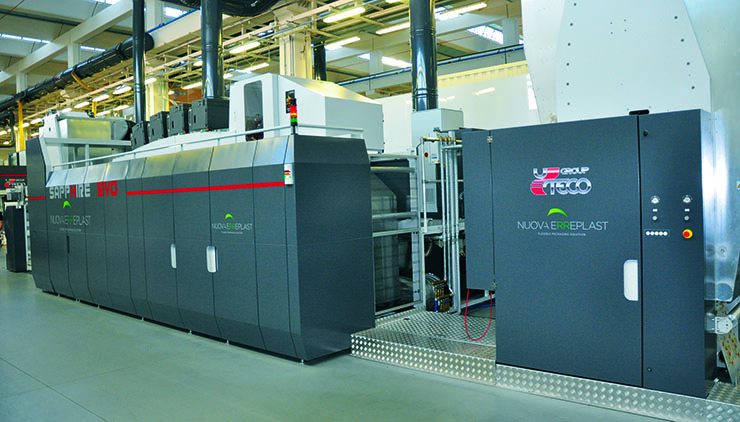As Uteco gets ready to ship the first Sapphire Evo, a group of analysts visited the company’s headquarters in Verona to catch up on the progress of the hybrid press, which has been developed with Kodak inkjet technology. Sean Smyth reports from Italy.
Uteco is further along the digital press journey than many competitors, certainly in the vanguard of adoption into high volume flexible packaging. Its Sapphire Evo features unwind, flexo priming station, four-colour Kodak Stream continuous inkjet units (622mm wide), hot air drying that supports the web and a final flexo unit to print base white for reverse printing or a coating, then into a rewind station. It uses water-based inks for food safe printing at speeds up to 300m/min. Other configurations will be available for specific applications.
First buyers revealed
The first machine has been sold to Naples-based Nuova Erreplast, with the second going to Kinyosha, in Japan, and third to the USA.
Nuova Erreplast was founded in 1980 and it produces a range of flexible packaging, mostly for food. The company is growing rapidly, with turnover increasing from €3.5 million in 2009 to €35 million in 2018, and during that time it has bought four Uteco flexo presses. CEO Domenico Raccioppoli said, ‘We want to continue growing and develop fully automatic operations to provide better service to customers. We are digitising the process, so wanted a digital press in the system not to fight with flexo, but to respond to market trends of immediate short runs, helping reduce time to market for new product launches. It will help us move into smaller quantities of 100–200kg, using the same substrates and soft-touch varnishes. If successful, we can then scale up to flexo and the customer sees no difference.’
He continued, ‘As we operate Uteco presses, it was natural to discuss their view of the future; we pushed the development and bought the Sapphire Evo. It is the first high performance digital press for flexible packaging, and it passed our testing procedures for surface and reverse printing with subsequent lamination. We will take the press at the end of February. I think the use of a digital machine for this new business opportunity is critical.’
Refinement
The development cycle for this installation saw Uteco refining and proving the press at its Converdrome facility, where it ran many jobs and conducted the food safety and performance testing. Initial trials for dried pasta was followed by meat and cheese certification using multilayer constructions for films and pouches. The final peel resistance test reached >2N per cm with primer, aqueous inks and adhesives, meeting the necessary bond strength needed to pack cheese, which was the last hurdle.
Aldo Peretti, president and CEO of the Uteco Group, said, ‘The adoption of this hybrid digital web press is showcasing the value of digital printing with water-based inks on flexible substrates for a wide variety of applications including food packaging and personal care items. The combined knowledge of Uteco and Kodak has unleashed the possibilities, and customers have taken notice.’
The Kodak Stream technology has no white, hence the hybrid configuration with flexo to lay down white. The primer allows use of water-based inks on all filmic substrates at high quality.
Kodak is now pushing its Ultrastream technology, which uses the same ink as Stream, but smaller printing drops translating to a 5–10% ink reduction. The heads have no airduct making them smaller and lighter, and also easier to integrate as they can be mounted on a rail rather than in a jet head mount, with the capability of a maximum width of up to 2.5m. Kodak is positioning this as ‘Creative Freedom’, with Uteco the first publicly announced development partner.
No details of developments were announced, but the first products may be for very high-quality label printing at speeds higher than generally available, or to allow wider web flexible packaging applications, probably in a hybrid configuration with flexo print and coating capability as well as inline priming.






